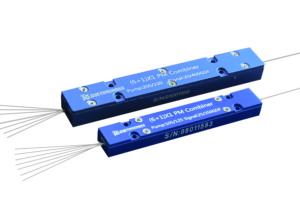 An optical filter is a small device designed to selectively transmit light of certain wavelengths. Each optical filter is characterized by its frequency response which specifies how the magnitude and phase of each frequency component of the incoming signal are altered by the filter. Mostly optical filters belong either to the category of absorptive filters or to the category of interference or dichroic filters.
An optical filter is a small device designed to selectively transmit light of certain wavelengths. Each optical filter is characterized by its frequency response which specifies how the magnitude and phase of each frequency component of the incoming signal are altered by the filter. Mostly optical filters belong either to the category of absorptive filters or to the category of interference or dichroic filters.
Optical filters are used for selectively transmitting light in a particular range of wavelengths, i.e. colors, and absorbing the remaining wavelengths. Based on its type, an optical filter can pass long wavelengths only (longpass), short wavelengths only (shortpass), or a band of wavelengths while blocking longer and shorter wavelengths (bandpass).
Thus, a fiber bandpass filter is a specific type of optical filter. While all fiber bandpass filters are optical filters, not all optical filters are fiber bandpass filters.
What are optical filters and fiber bandpass filters used for?
Most optical filters are used for optical imaging and are transparent. Some filters that are used for light sources are translucent. Common optical filters are used in photography, optical instruments, and color stage lighting. Some optical filters are also used in astronomy to restrict the light passed to the spectral band of interest and in fluorescence applications such as microscopy and spectroscopy.
However, fiber bandpass filters such as 1064nm bandpass filters are more commonly used to block unwanted noise signals in a broad range of systems and applications such as fiber amplifiers, fiber laser systems, EDFA systems, DWDM systems, high-speed communication systems, and instrumentation applications.
Fiber bandpass filters are one of the most cost-effective and simplest ways to pass a specific band of light while blocking all the remaining unwanted radiation.
What are 1064nm bandpass filters?
The 1064nm bandpass filters are micro-optics devices that work on environmentally stable thin-film filter technology. They are designed to block out all the unwanted noise signals in fiber systems, such as fiber amplifiers and laser systems. These bandpass filters are characterized by the following features:
- High isolation
- Low insertion loss
- High return loss
- Excellent environmental stability
- High-power handling capacity (only in high-power bandpass filters)
Specifications of standard 1064nm bandpass filters are:
- Center wavelength: 1064nm
- Maximum pass bandwidth at 0.5dB: 2nm, 5nm, and 8nm
- Maximum stop bandwidth at 30db down: 6nm, 12nm, and 20nm
- Maximum insertion loss of pass band: 0.8dB, 0.8dB, and 0.8dB
- Maximum PDL: 0.10dB
- Minimum return loss: 50dB
- Fiber Type: 1060-XP fiber
- Maximum power handling capacity: 0.3W, 1W, 2W, 3W, 5W, and 10W
- Maximum tensile load: 5N
- Operating Temperature: -5 to 75 degrees Celsius
- Storage Temperature: -40 to 85 degrees Celsius
- Dimensions: Ф5.5×L35
All these specifications of a 1064nm bandpass filter are for standard models only. For specific applications that require bandpass filters with custom specifications, reputable manufacturers like DK Photonics can also design custom bandpass filters.

Leave A Comment